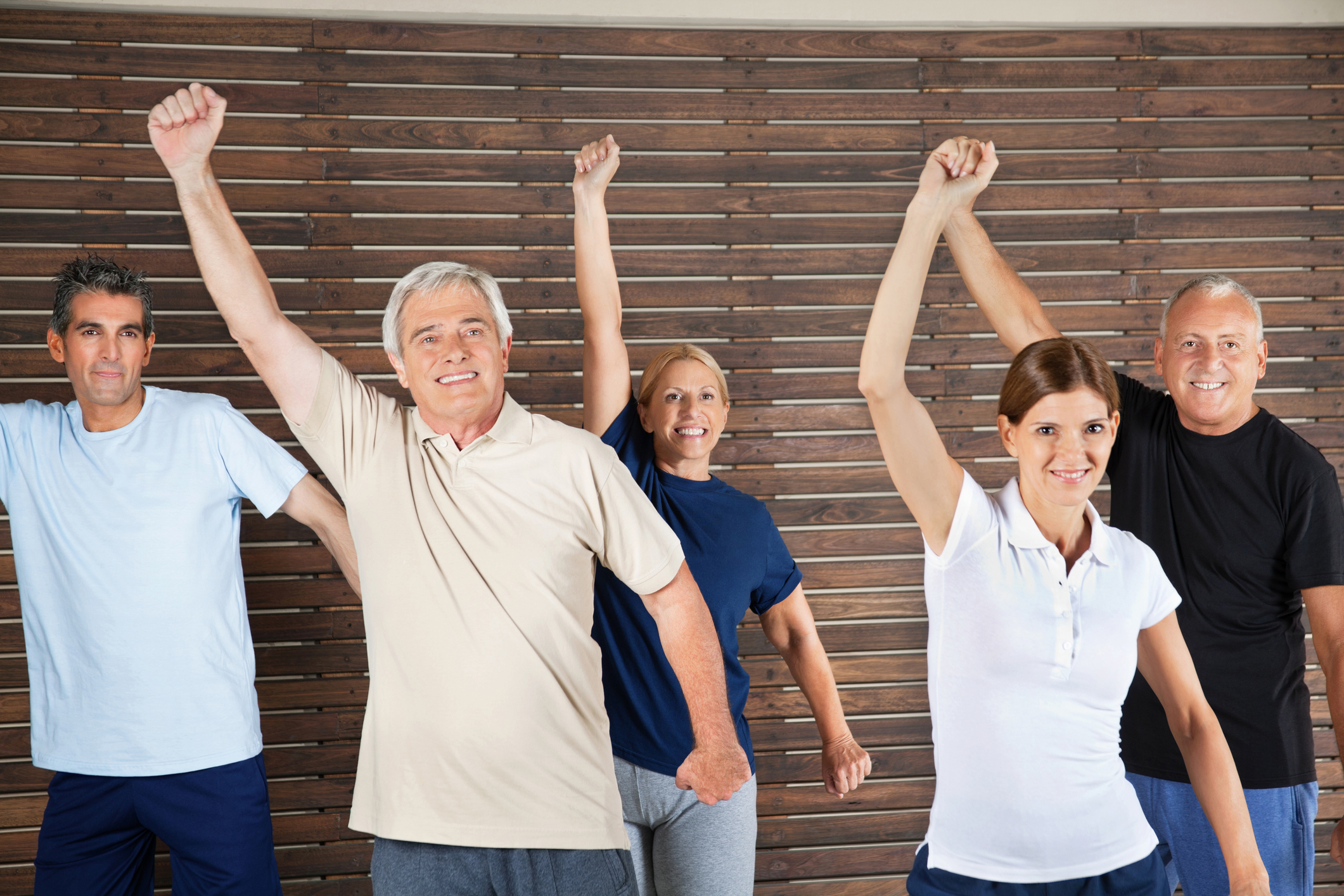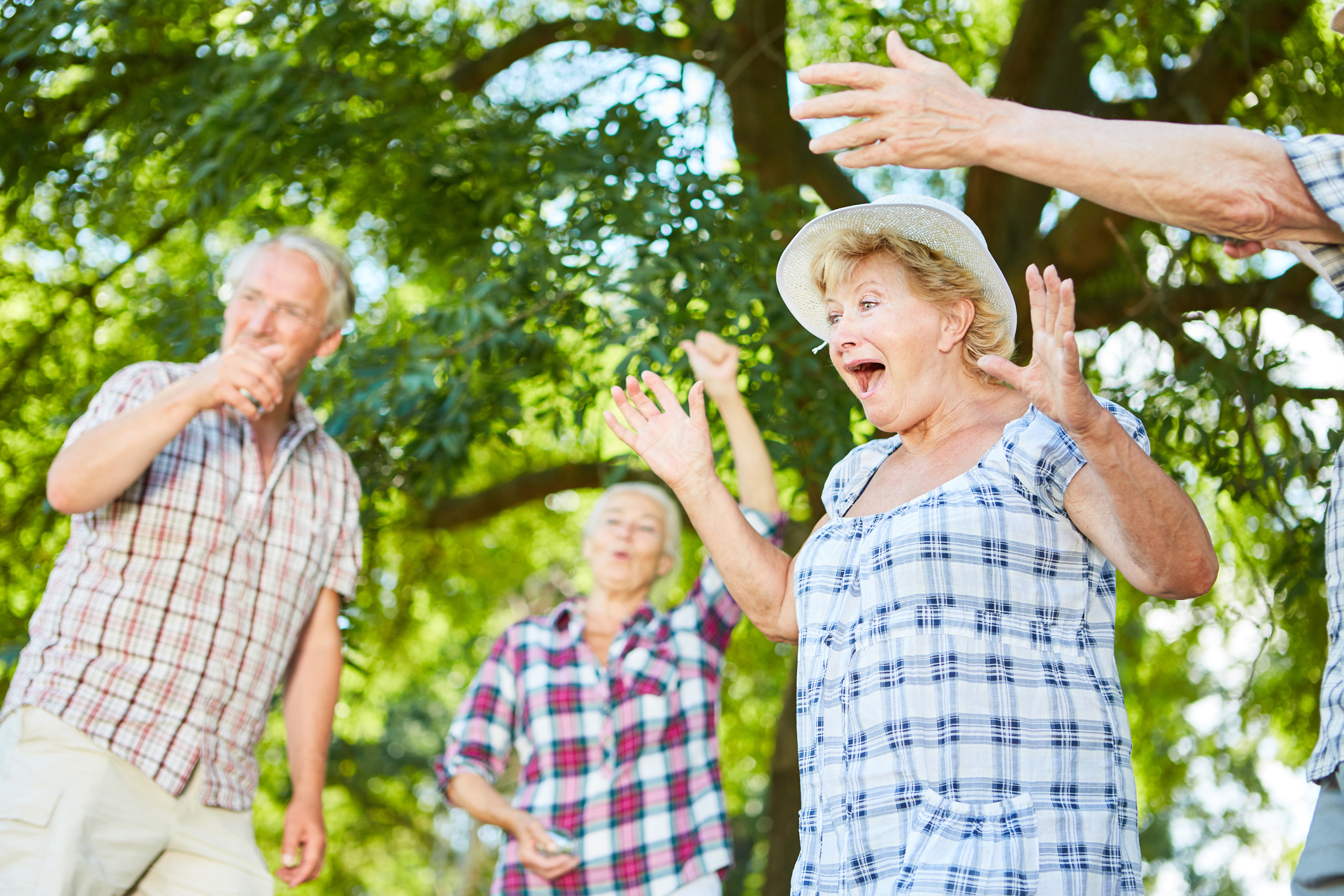Strength Exercises for Seniors
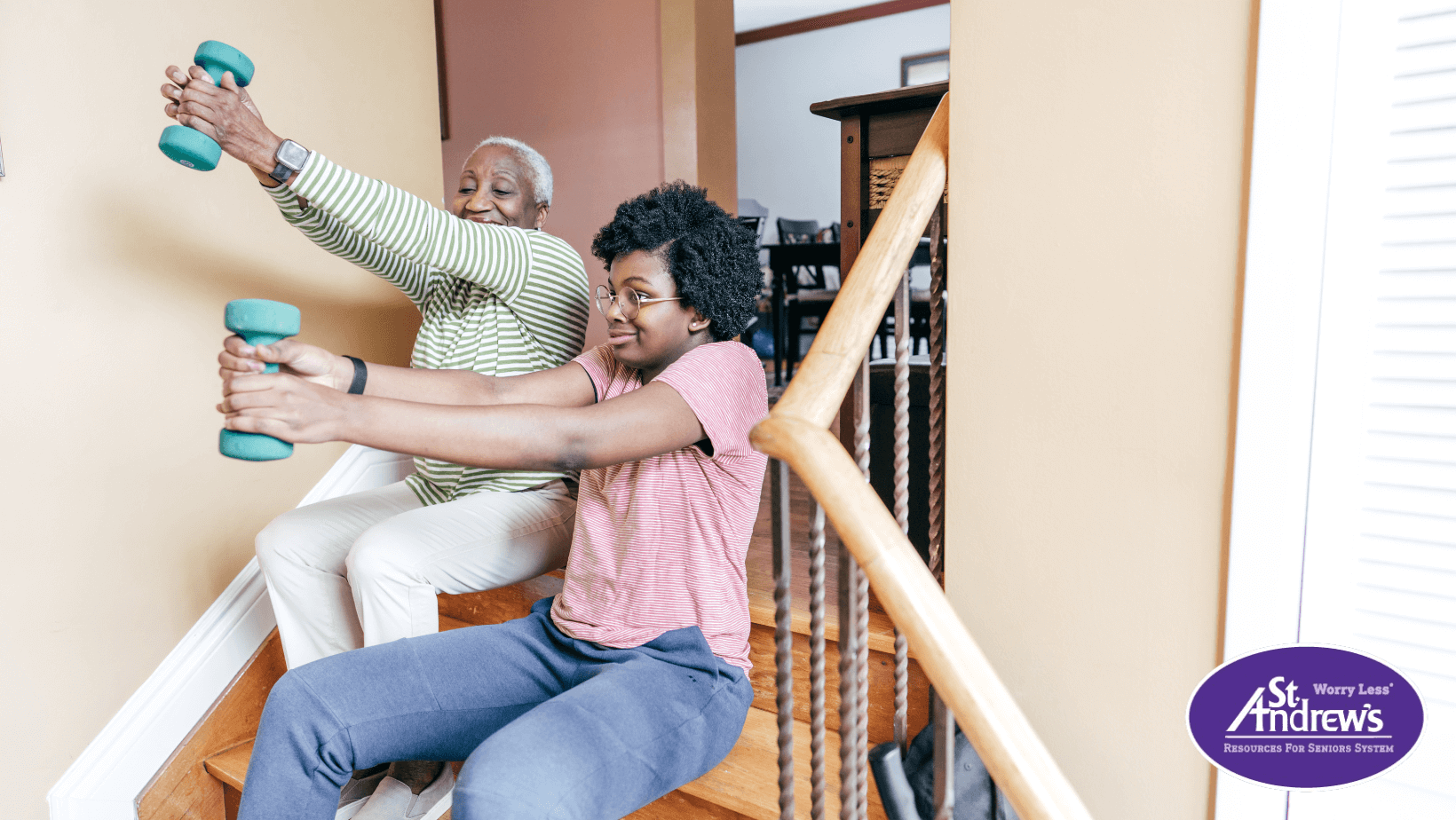
While many people associate strength exercises with young people in the gym, the truth is that anyone can benefit from strength-training exercises, especially older adults! In fact, it could be even more important to start or maintain a balanced exercise routine that includes strength-building components while aging.
Health benefits of strength-training exercises for seniors include:
- Keeping a healthy weight
- Reducing the odds of heart disease
- Reducing age-related muscle loss
- Combating the effects of osteoporosis
- Potentially reducing lower back pain
- Potentially improving symptoms of arthritis
Potentially improving bone density
Create an Exercise Program for Older Adults
Physical activity is just as important for aging people as it is for younger people. It's important to have a healthy blend of balance exercises, stretches, strength-training activities, and cardiovascular exercise routines.
For now, let's focus on the strength-building ones.
When establishing a senior exercise program, it's important to keep the following in mind:
- Always establish a baseline of fitness and then work from there; don't jump into a difficult program without understanding your individual fitness level. It could not only lead to frustration, but also increase the risk of major injury. You can go here to learn more about establishing a baseline.
- Prioritize good form over speed and weight. Getting faster and adding more weight to routines will happen with time, so don't rush it. What is most important is getting the form down perfectly so that you can build upon that solid foundation and decrease the risk of injury from improper form.
- Be patient; increase repetitions and add weight slowly. Think of improvement over the span of weeks and months, not hours and days.
- Never neglect warm-up and cool-down exercises.
- Understand how much physical activity older people need. According to the CDC, older people need a weekly average of 2 1/2 hours of moderate-intensity cardio exercises (or 1 hour and 15 minutes of vigorous-intensity cardio exercises), 2 days of muscle-strengthening activities, and additional activities to improve balance.
- Vary routines to avoid stagnation. Performing the same exercises without variance can lead to what is known as plateauing, where you no longer get the same benefits from the routine since your body has adjusted to your workout program. Find new exercises that work similar muscle groups in different ways to avoid stagnation.
- Rest between sets. A repetition, or rep, is one completion of an exercise. A set is finishing a specific number of reps. Resting between each set can improve strength and reduce the odds of injury. Many experts recommend resting periods of one to three minutes between sets for older people.
Best Strength-Training Exercises for Older Adults
Whether you or your loved one is new to the game or an old pro, it never hurts to review what exercises are best for your age group. Below are some of the best exercises older adults can perform to build or maintain their muscle strength.
Warm-Ups
Warm-ups get the blood flowing and joints loose and limber, which helps reduce the odds of injury during workouts.
A great warm-up activity for older people is to jog in place for 60 to 90 seconds.
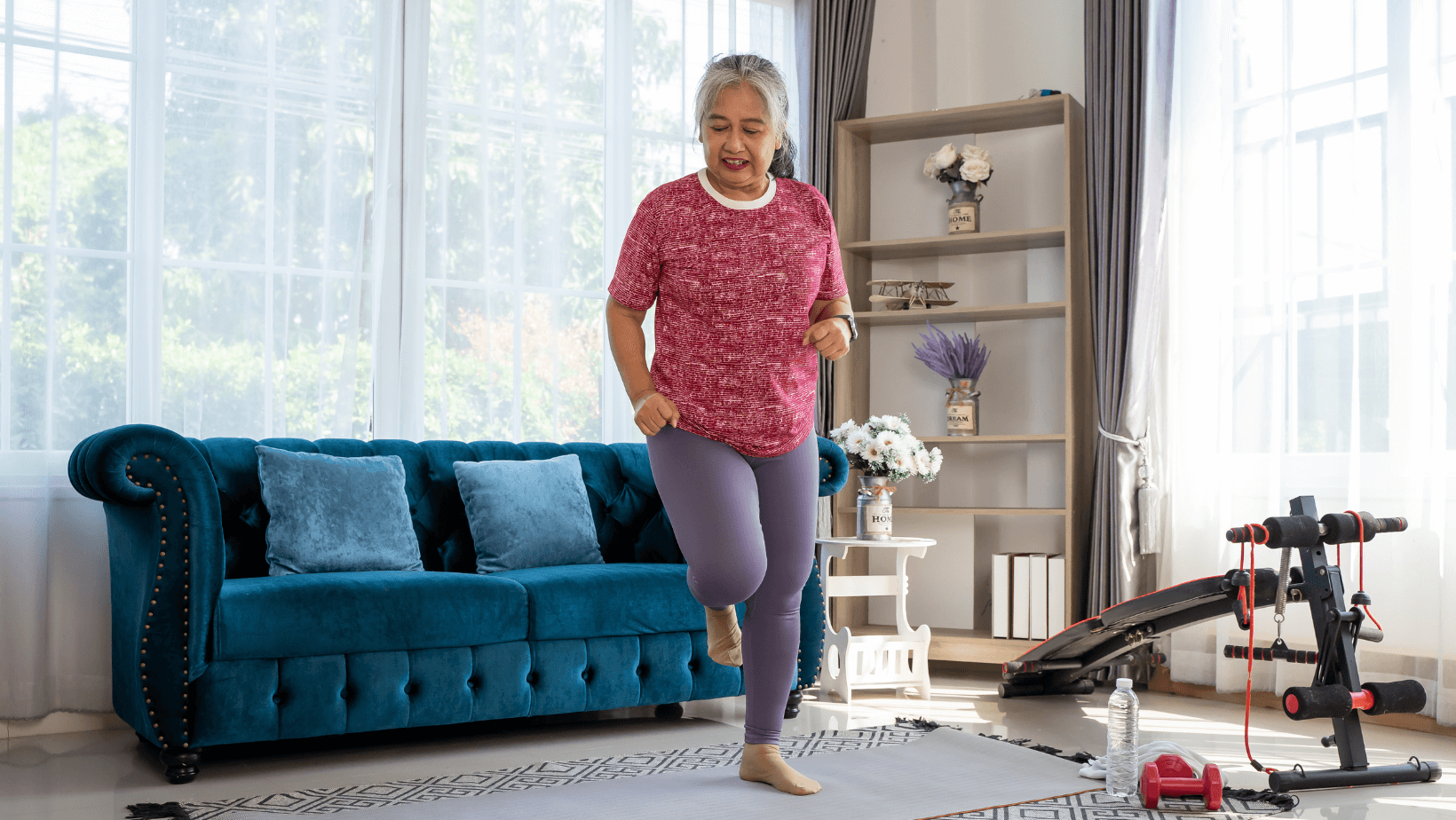
Push-Ups
Once warmed up, it's time to move on to the workout routine itself, and there is no better place to start than push-ups. Classic push-ups are great body weight exercises that people of any age and most fitness levels can perform. Best of all, they require absolutely no equipment, so a fancy gym isn't necessary.
The Exercise:
- Beginning form is a high plank, with the shoulders above the hands and the hands splayed on the ground, shoulder-width apart. Make sure the body is in a straight line; if the back is arched either up or down, it may be best to start with a modified push-up (see below).
- Move from the starting position slowly down to the floor, keeping the glutes and core engaged the entire time.
- Hold for a breath and then push back up to start. This completes one rep. Older adults should aim for roughly 5 to 12 reps.
Modifications:
- Wall push-ups for beginners
- Balance on knees and put cushioning mats or towels under the joints for beginners
- Forearm push-ups for people with wrist pain
Don't Do If:
- Experiencing current or former wrist injuries
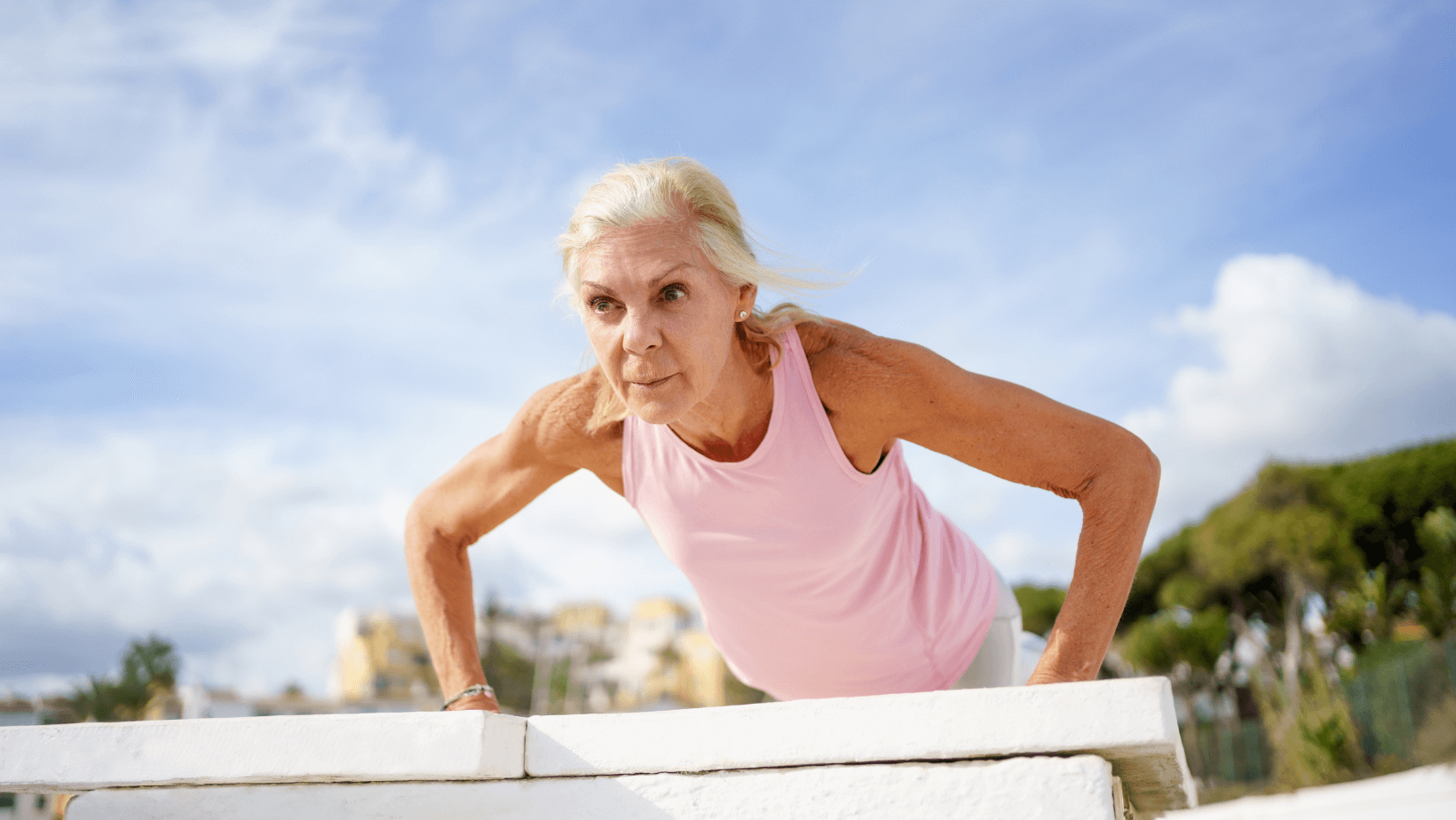
Bicep Curls
Bicep curls are what many people consider the quintessential upper body strength-training exercise. What's great about this activity is that you can incorporate a variety of equipment to it, including free weights and resistance bands.
The Exercise:
- To start, stand with weights or bands in hand, with hands at resting position down by the hips/thighs. The feet should be roughly hip-width apart.
- With palms facing up and wrists rigid and straight, move the forearms slowly up toward the shoulders. The back should be straight, with hips tucked and static. If the back arches or the arms and hips swing, it could be a sign that the weights are too heavy.
- Hold the weights at the shoulders for a breath, then slowly move the arms back down to the beginning position. This completes one rep. Many older people aim for 3 sets of 5 to 12 reps.
Modifications:
- Sit in a sturdy chair to reduce the risk of falls or poor posture
- Move one arm at a time
- Only bring the forearms up halfway rather than to the shoulders
Don't Do If:
- Recovering from an arm injury
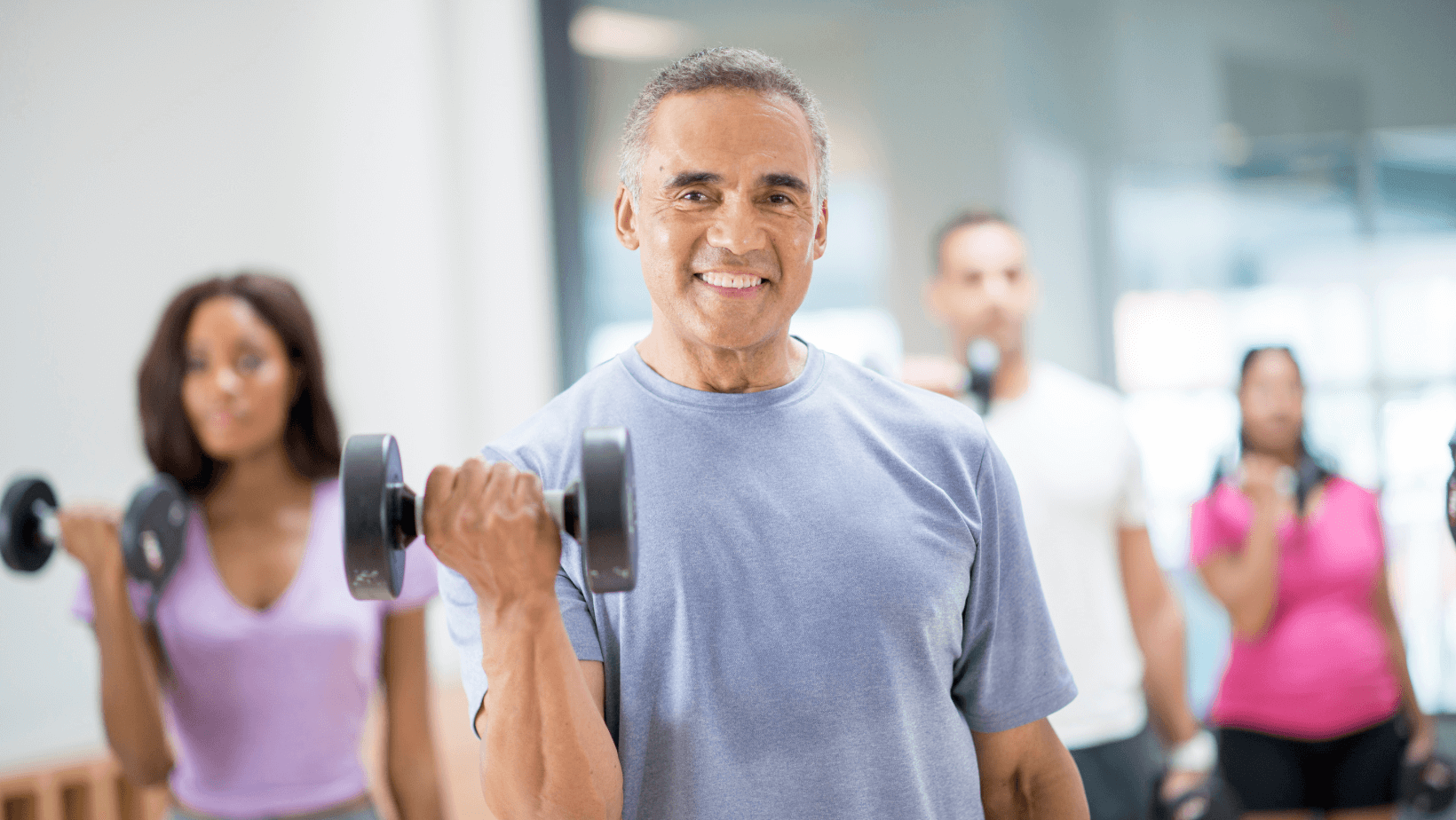
Tricep Dips
Build strength in the upper body by working more than just the biceps. Work other muscle groups of the arms and upper body, like the triceps, to balance overall upper body strength.
The Exercise:
- To start, place the hands shoulder-width apart on a countertop or bench, with both legs extended in front of the body. The hands should be pointing forward.
- Slowly lower the body using only the arms until the elbows reach a 90-degree angle. Make sure the elbows are close; do not let the elbows extend outwards.
- Hold for a moment and then slowly extend the arms again until reaching the start position. This completes one rep. Many seniors aim for 3 sets of 5 to 12 reps.
Modifications:
- Perform on the floor
Don't Do If:
- Lacking upper body strength (these dips are not for strength-training beginners)
- Experiencing a shoulder or back injury
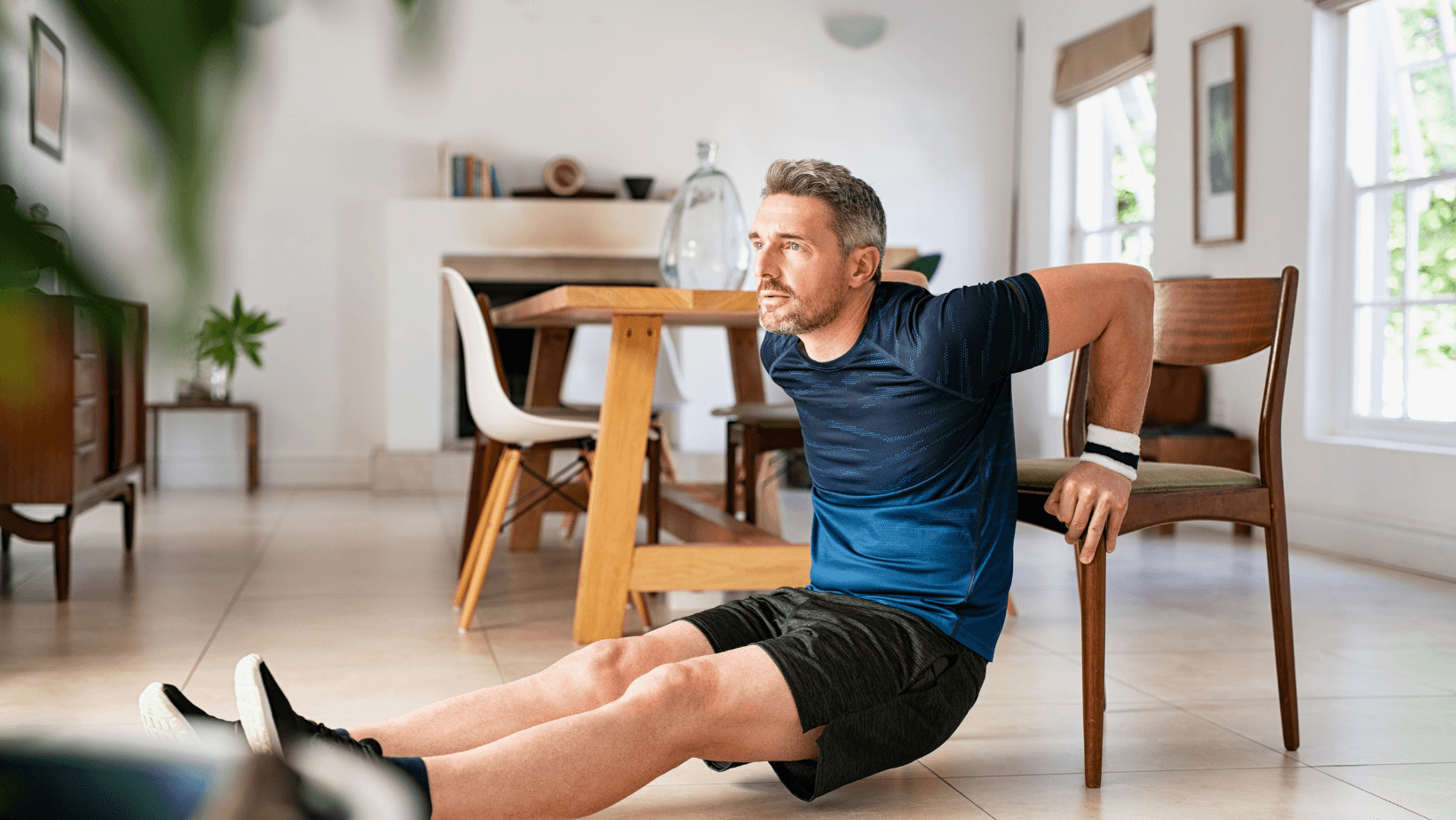
Tricep Extensions
Tricep dips aren't the only way to work the triceps; tricep extensions can also work this muscle group.
The Exercise:
- To begin, grab a set of dumbbells. Have the feet roughly hip-width apart. Slowly bend the knees until in a semi-squatting position. Slowly bend the upper body forward, keeping the back straight. Hold the weight up at the shoulders, with arms close to the body. This is the beginning posture.
- Slowly move the arms backwards until fully extended behind the body, with the arms close to the body. Keep the core engaged the whole time, with the hips tucked. If the back arches, it could be a sign that the weights are too heavy.
- Hold for a moment, then slowly move (do not swing) the arms back into a starting position. This completes one rep. Many older people aim for 3 sets of 5 to 12 reps.
Modifications:
- Use one arm at a time
- Sit on a chair
- Have one leg kneel on a bench, with the other leg on the floor, working one arm at a time
- Use resistance bands rather than dumbbells, with the feet holding the bands in place
Don't Do If:
- Experiencing a shoulder or back injury
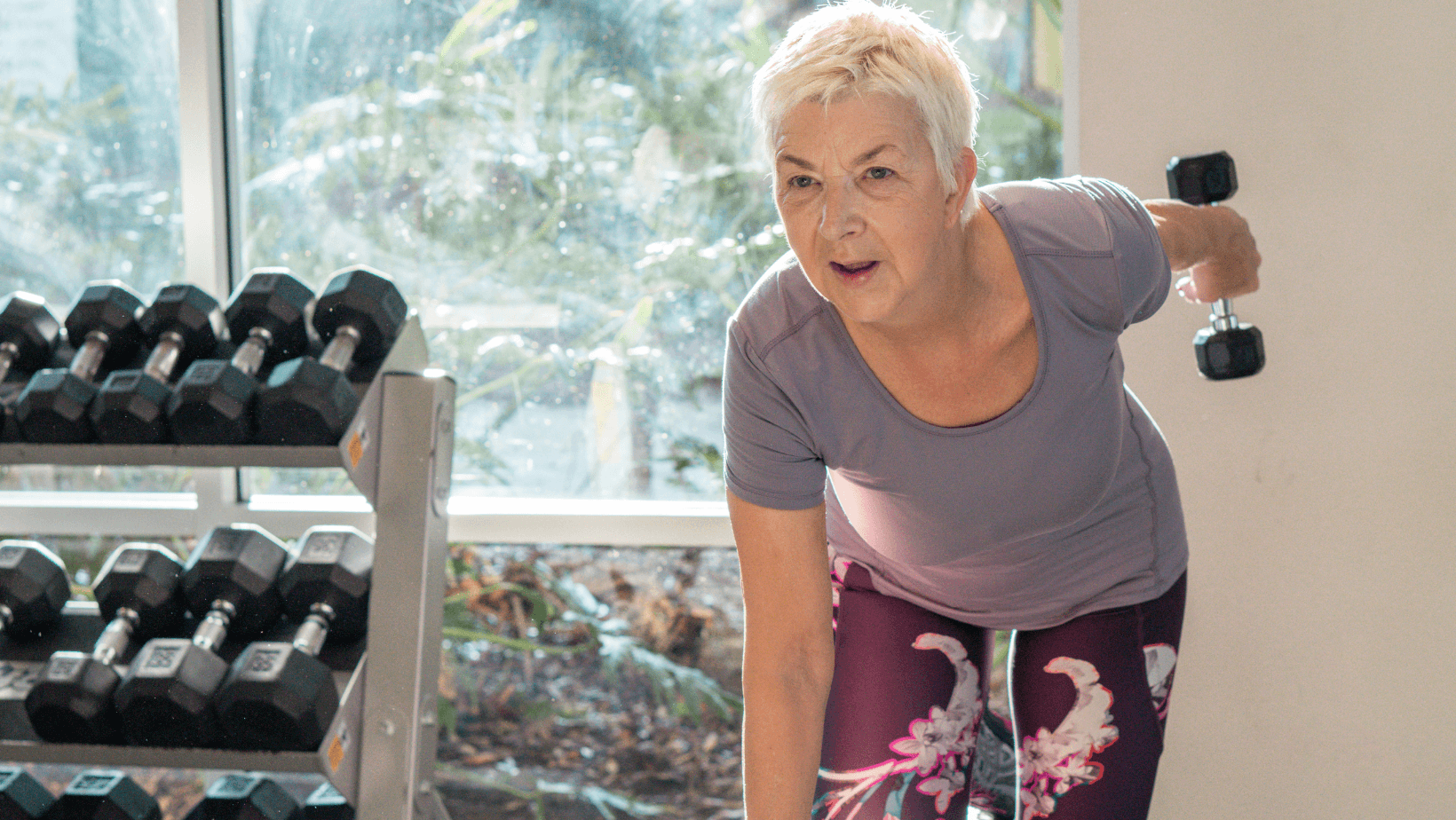
Shoulder Shrugs
The muscles of the upper body all require exercise in order to grow together in a balanced manner. Balance out the biceps and triceps with trapezius (trap) exercises like dumbbell shoulder shrugs.
The Exercise:
- Grab a set of dumbbells and hold them relaxed at the hips/thighs. Keep the feet about hip-width apart.
- Keeping the hips tucked and the back straight, move the shoulders in a circle. Finishing a "circle" completes one rep. Many aim for 3 sets of 5 to 12 reps.
Modifications:
- Do one shoulder at a time
- Perform without weights
Don't Do If:
- Experiencing a shoulder or back injury
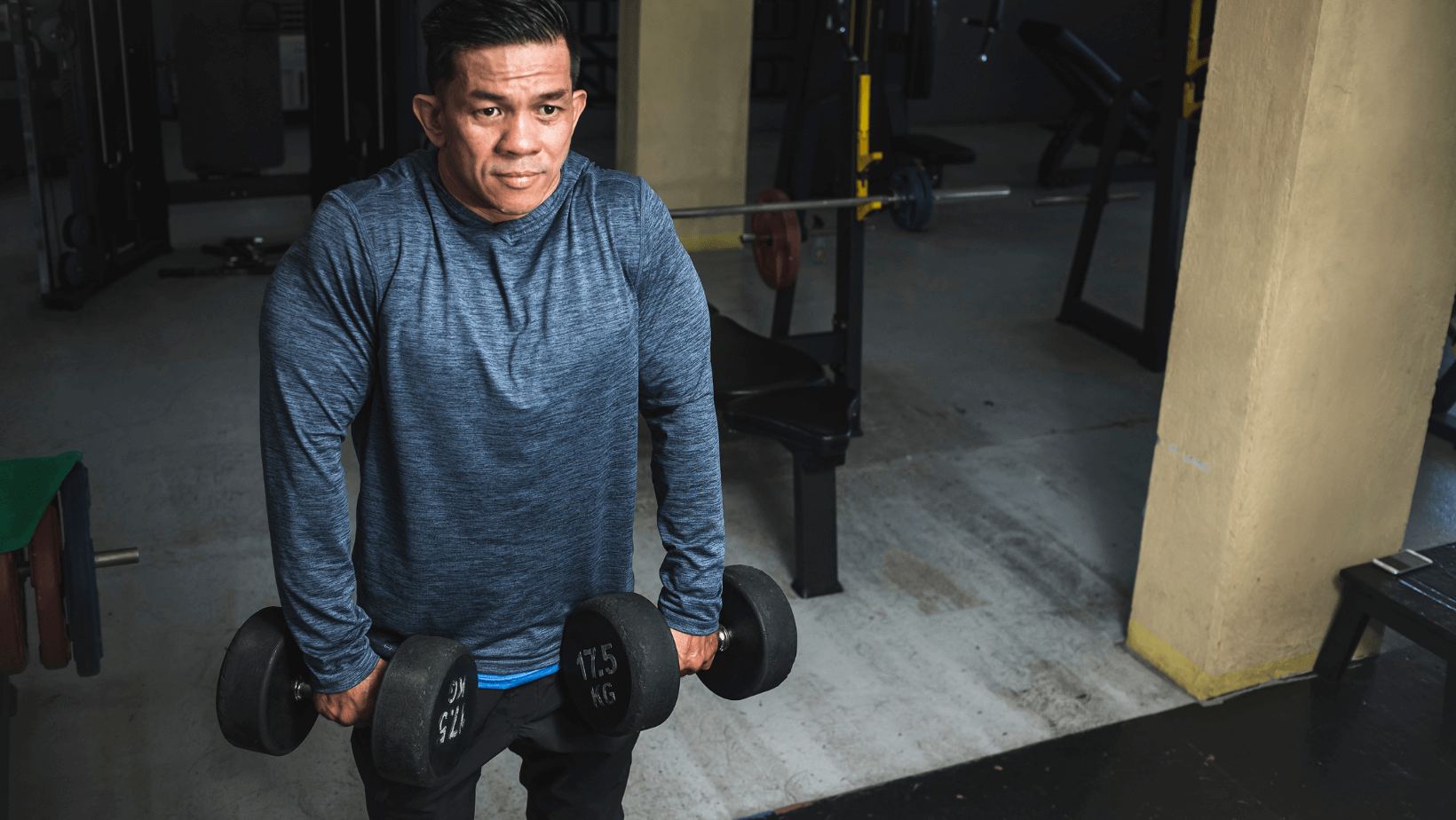
Overhead Shoulder Presses
One easy way to work out upper body muscles, including those of the chest, is with an overhead shoulder press.
The Exercise:
- Hold weights in the hands, with palms facing forward. Hands should be about shoulder level with elbows close to the body.
- Push the arms up slowly until the arms are over the head, fully extended (but do not lock the elbows). Keep the hips tucked, back straight, and chest open the whole time. Curving the back is a sign that the weights are too heavy.
- Hold, then return to start. Many people aim for 3 sets of 5 to 15 reps.
Modifications:
- Do one arm at a time
- Sit down while performing
Don't Do If:
- Recovering from a back injury or have a severe previous back injury
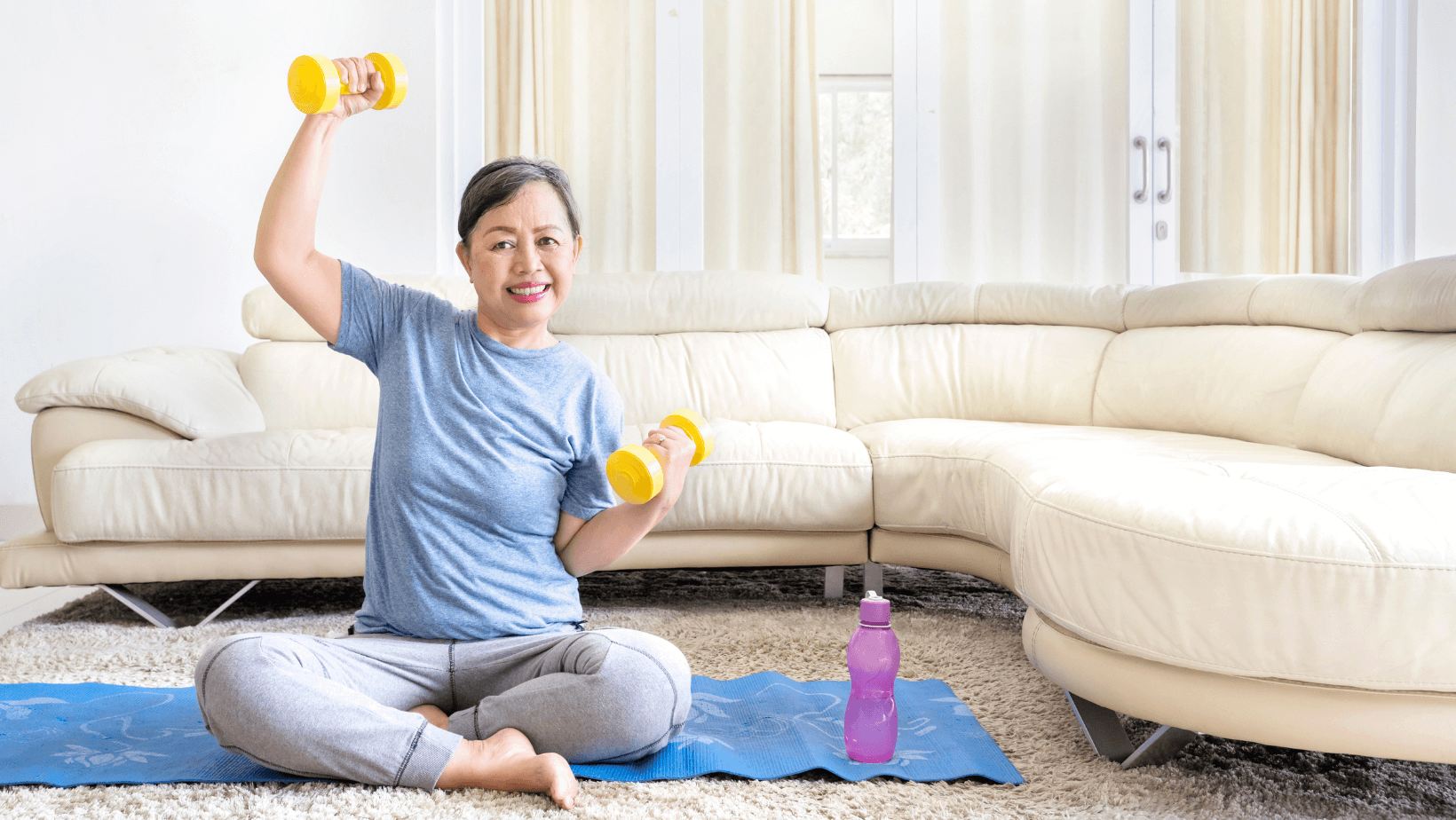
Dumbbell Front Raises
Another great way to work out the chest and shoulders is with dumbbell front raises.
The Exercise:
- Hold dumbbells down in front of the body at thigh level with the palms facing in. Feet should be a little wider that hip-width apart.
- Keeping the elbows slightly bent with the back straight and hips tucked, slowly raise the arms to chest level, keeping the arms parallel to the ground. If the back arches, it is a sign that the weights are too heavy.
- Hold for a moment, then slowly lower the arms back to the beginning position. This completes one set, and many people perform 3 sets of 8 to 15 reps.
Modifications:
- Drop the weights
- Swap out the dumbbells for a resistance band, held in place by the feet
- Do one arm at a time
- Sit down while performing if balance is a concern
Don't Do If:
- Recovering from a back injury or have a severe past back injury
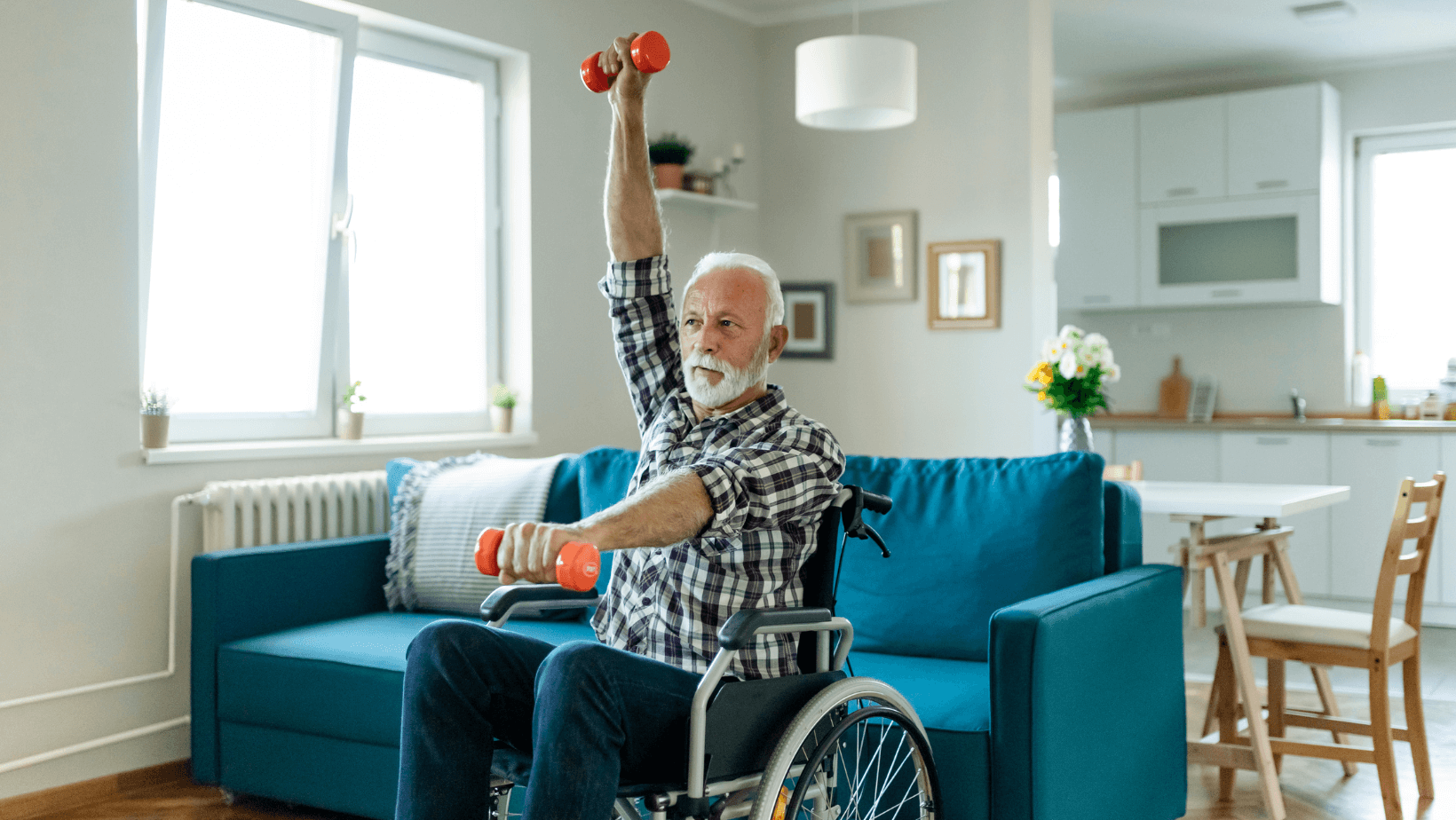
Dumbbell Lateral Raises
The lateral raise is a fantastic complementary exercise to the front raise.
The Exercise:
- Hold the dumbbells at the sides of the body, with palms facing in. The hands should start at thigh level.
- Keeping the elbows slightly bent with the back straight and hips tucked, slowly raise the arms up until reaching chest level. Stop when the arms are parallel to the ground; the final form should resemble the letter T. If the back arches at any time, it is a sign that the weights are too heavy.
- Hold for a moment, then slowly lower the arms back to the beginning position. This completes one set, and many people perform 3 sets of 8 to 15 reps.
Modifications:
- Drop the weights
- Do one arm at a time
- Sit down while performing
- Swap out the dumbbells for a resistance band, held in place by the feet
Don't Do If:
- Recovering from a back injury or have a severe past back injury
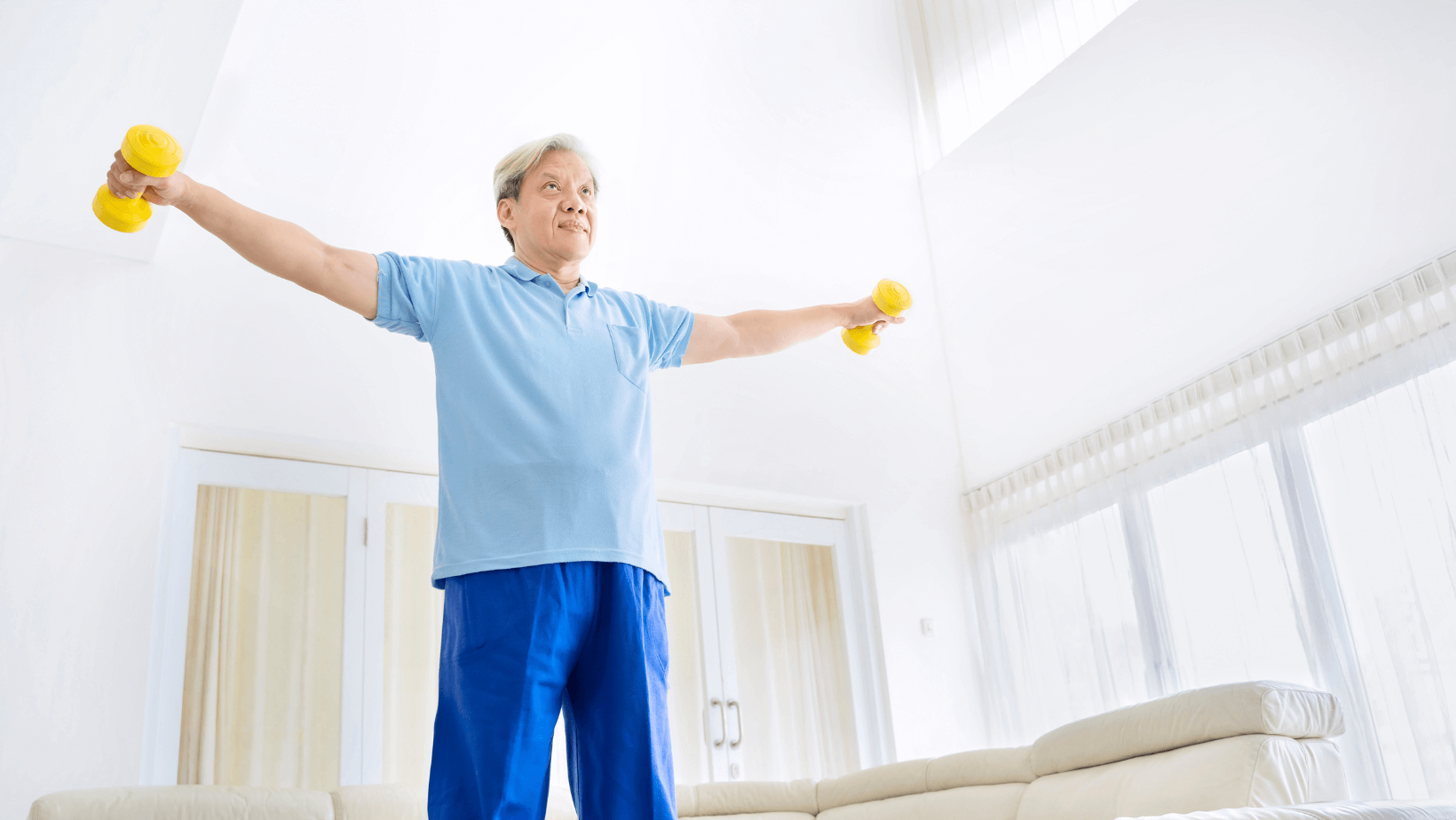
Side Bends
Never neglect the core when exercising. Side bends are one of the most tried-and-true ways to work out the obliques, muscles along the sides of the torso.
The Exercise:
- Start with legs roughly shoulder-width apart, with a dumbbell in one hand; the palm should face inward. The hand not holding the dumbbell can rest on the hip.
- Use the core to push the dumbbell down, until it roughly reaches knee level. The legs should be slightly bent, with the chest open and shoulders back (as in, do not slouch forward).
- Hold, then slowly return to the starting position. This completes one set, and many people complete 3 sets of 8-15 reps on each side.
- Repeat on the other side for the same number of times.
Modifications:
- Swap out the dumbbells for a resistance band, held in place by the feet
- Remove weights for beginners
- Sit down while performing if balance is an issue
Don't Do If:
- Recovering from a back injury or have a severe past back injury
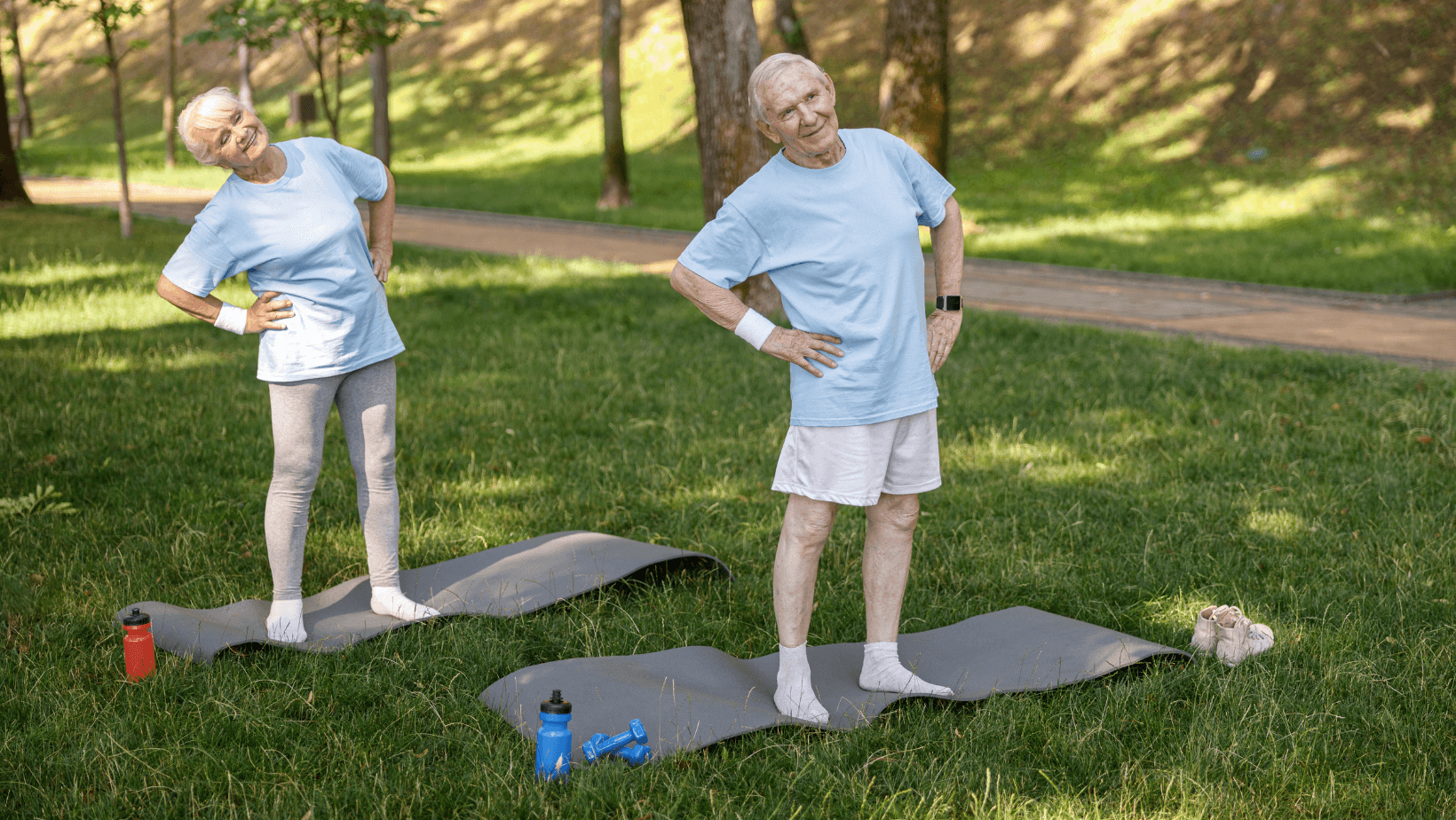
Lunges
It's important to never skip strengthening the lower body. Forward lunges build muscle strength in the quadriceps (front of leg) and glutes, making them a great exercise for people of almost any fitness level. Best of all, they are easy enough to perform with or without added equipment.
The Exercise:
- Start by standing with legs about hip-width apart with hands relaxed at the sides or on the hips.
- Keeping the left leg grounded, step forward with the right leg. The right knee should end up at about a 90-degree angle; do not let the right knee extend past the right foot. Keep the back straight, shoulders back, chest open, and the knee facing straight ahead (not off to the side) the entire time.
- Hold for a moment, then push back from the right foot and return to the starting position.
- Repeat, this time with the left leg. This completes one set. Many people aim for 3 sets of 5 to 12 reps.
Modifications:
- Add dumbbells or resistance bands for increased resistance
- Lunge backwards to work different muscles like hamstrings and glutes
- Hold onto a handrail for balance support
Don't Do If:
- Experiencing knee pain or recovering from a knee injury
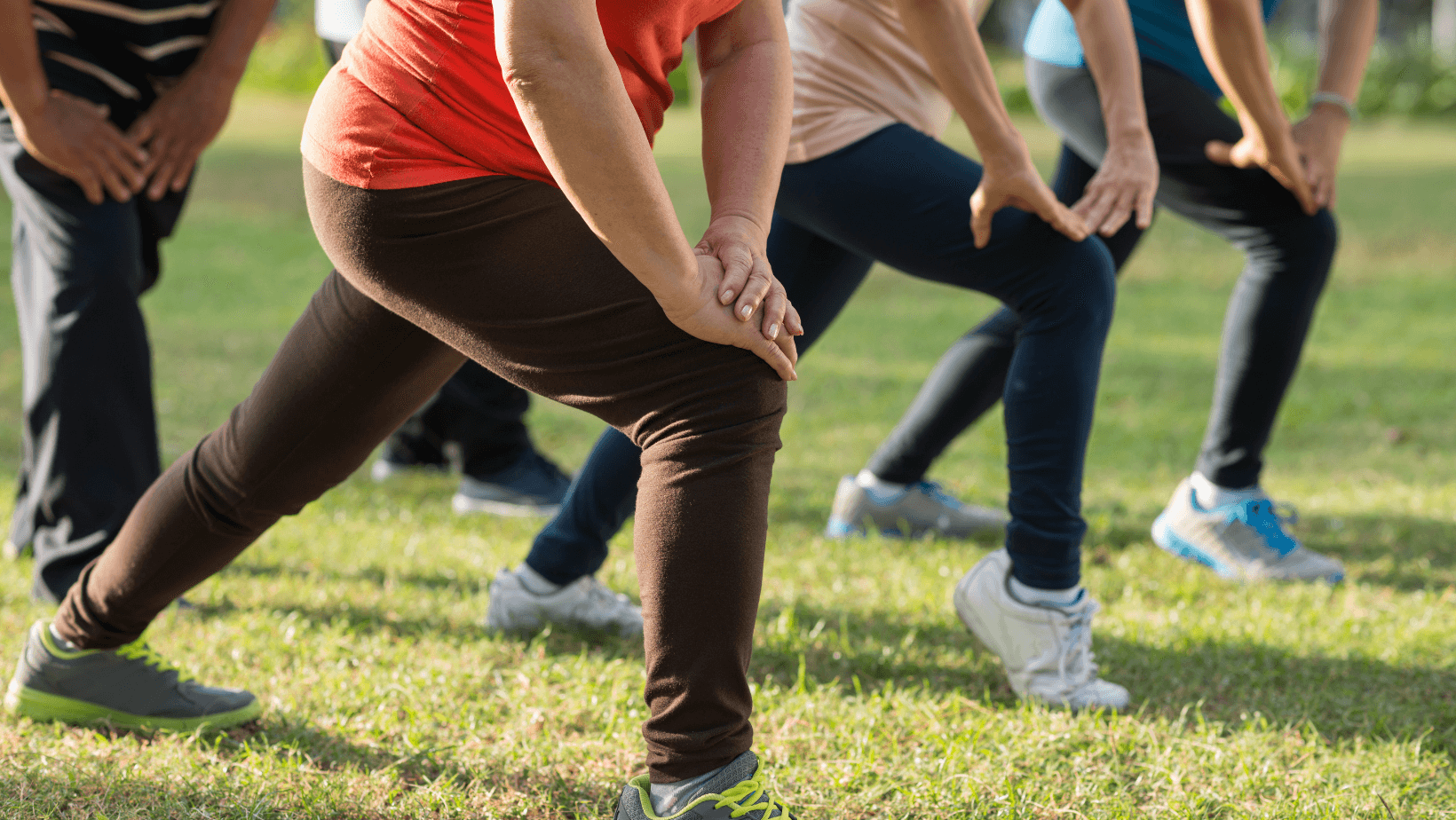
Side-Lying Hip Abductors
Hip abductors are good complementary exercises to lunges, helping to balance out any lower-body exercise program.
The Exercise:
- Lay on the ground, with hips and legs touching the ground and the upper body supported on a forearm. Legs should be one on top of the other and straight out.
- Raise the top leg in the air as high as is comfortably possible. Keep the back straight and shoulders back; do not twist the upper body. Keep the toes pointed forward.
- Hold the leg in the air momentarily and then slowly lower it to the starting position. This completes one rep. Many people perform this exercise between 10 to 30 times on one side.
- Repeat on the opposite side for the same number of times.
Modifications:
- Put resistance bands around the legs to increase difficulty
Don't Do If:
- Your doctor recommends avoiding this exercise
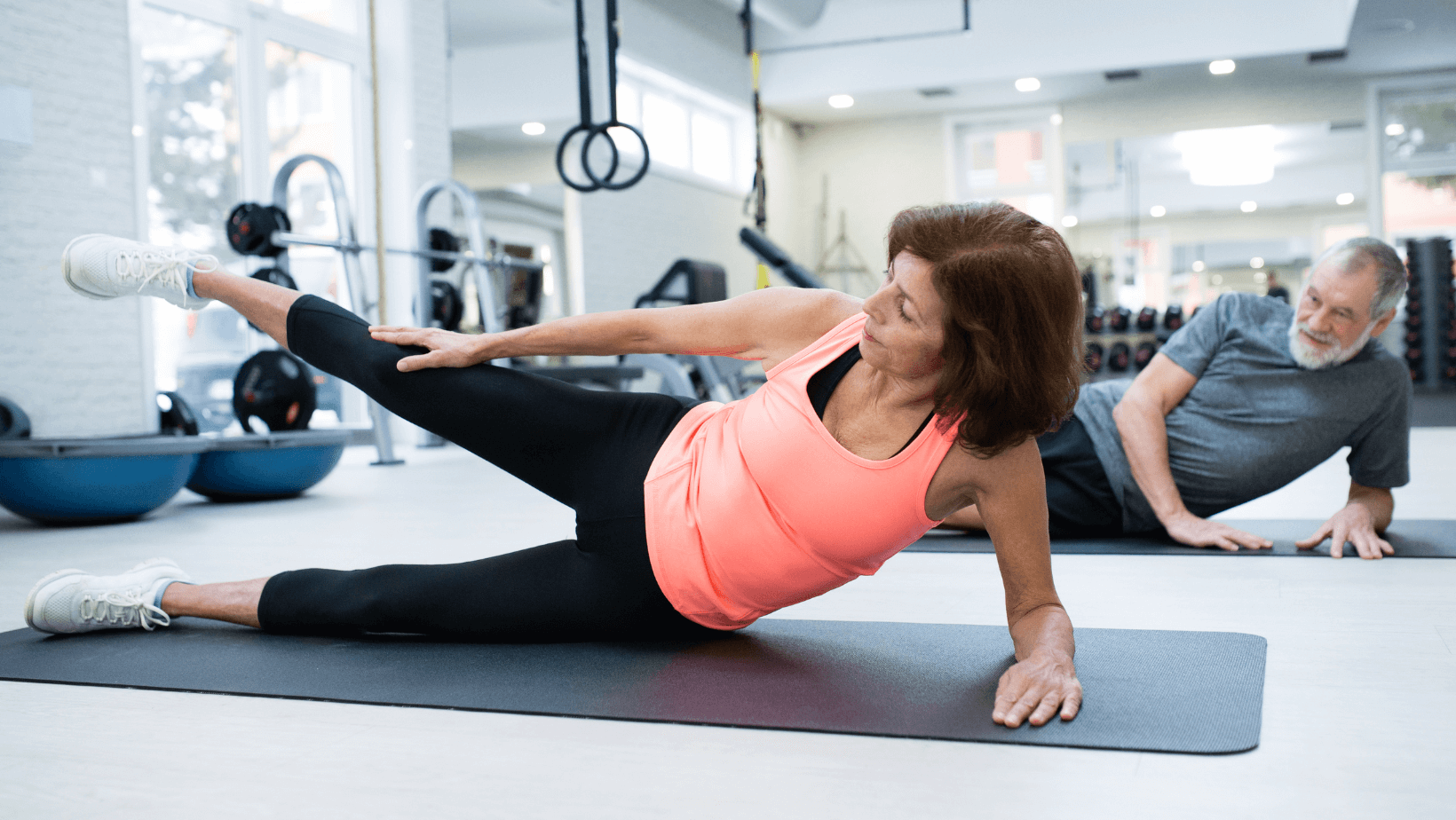
Step-Ups
Step-ups are another great lower-body exercise that most seniors can safely perform using either specialty step-up boxes or even a regular staircase.
The Exercise:
- Stand straight up with hands loose at the sides or on the hips.
- Take a step up on the stair or box until both feet are on the step.
- Push back to the starting position by stepping backwards. This completes one set. Many people perform this exercise between 10 to 30 times.
Modifications:
- Hold weights to increase resistance
- Use handrails for balance
Don't Do If:
- Experiencing severe balance issues
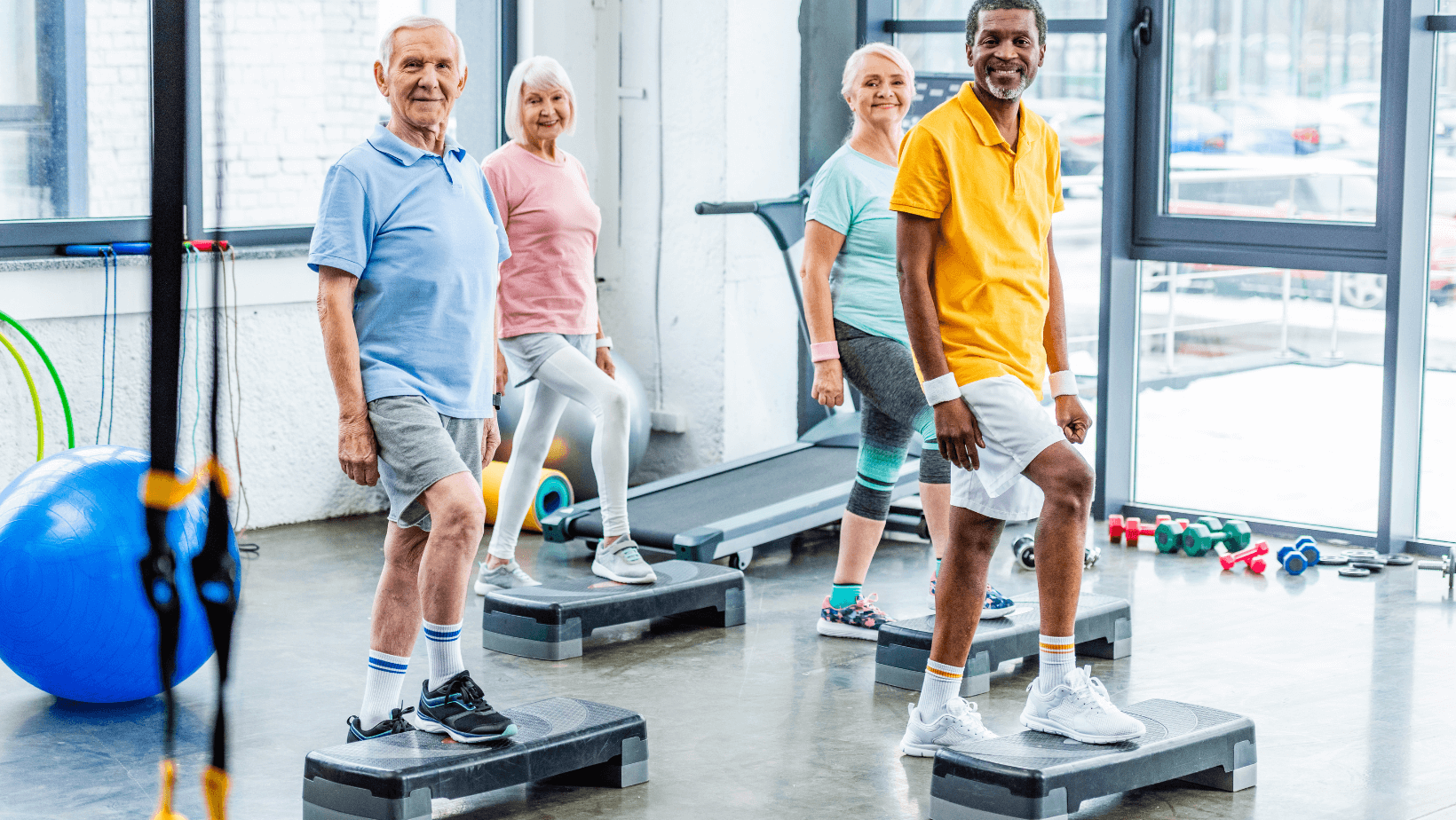
Squats
The squat is a great body weight exercise that works the glutes and can build muscle mass in the lower body.
The Exercise:
- Stand with legs a little more than hip-width apart. Hold the arms in front of the chest. Keep the core tight.
- Keeping the feet firmly planted, lower the body using the glutes until the legs are roughly parallel to the ground. The entire foot (both heels and toes) should remain firmly planted on the ground the whole time, with back straight, shoulders back, and hips tucked.
- Hold for a moment, then slowly return to start. This completes one set. Many people perform 3 sets around 8-15 times.
Modifications:
- Use a chair for balance
- Use handrails for balance
- Add free weights or resistance bands for added difficulty
Don't Do If:
- Experiencing a knee injury or similar issue
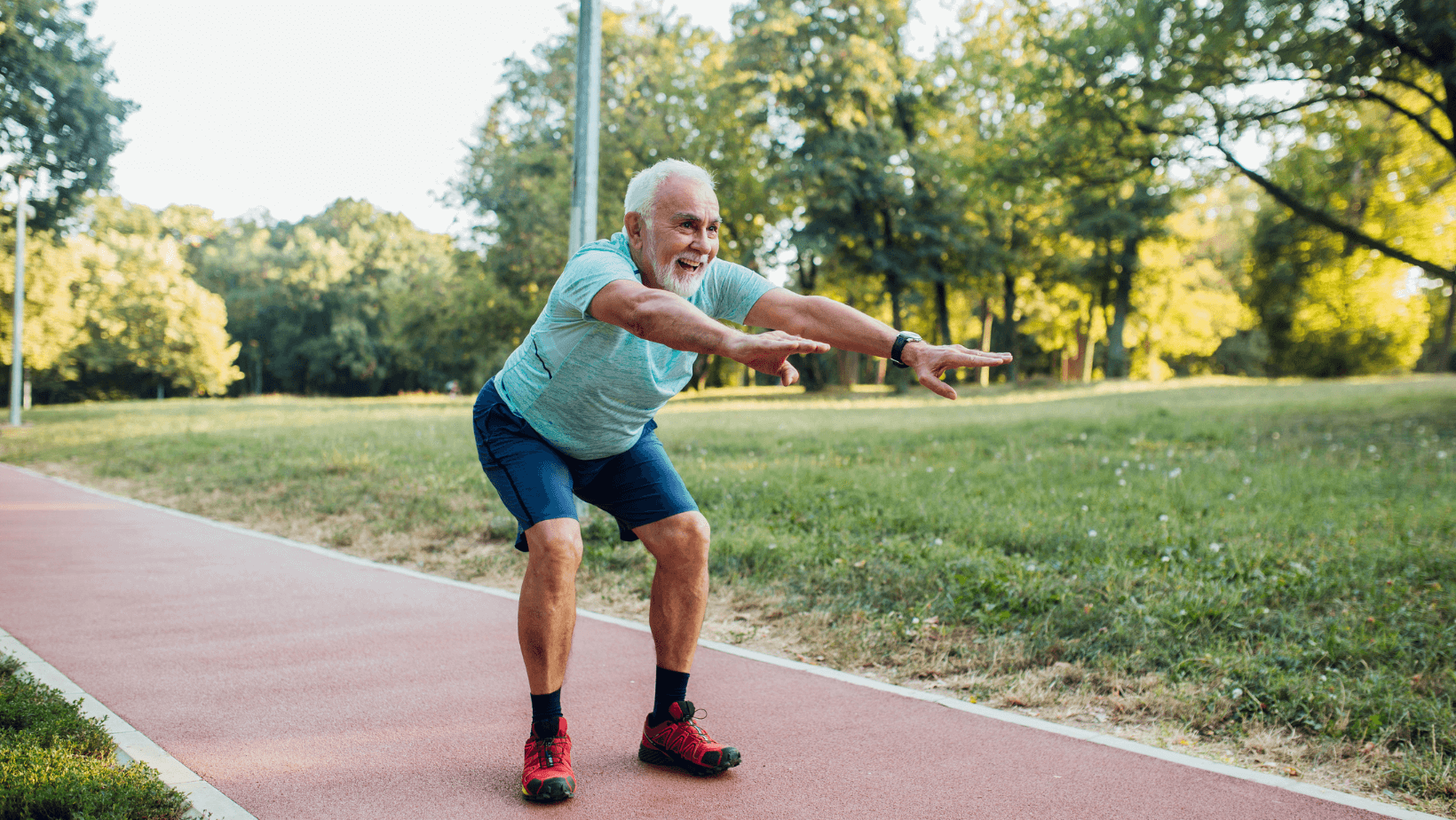
Calf Raises
Calf raises are easy enough for older people to perform while still offering an incredible workout.
The Exercise:
- Stand with the feet roughly hip-width apart, with hands loosely at the side or on the hips.
- Slowly raise the entire body using the muscles in the calves, balancing on the balls of the feet. Keep the back straight and the knees lightly bent.
- Hold for a moment before lowering the balls of the feet back down to the ground. This completes one set. Many people perform 3 sets around 10-20 times.
Modifications:
- Use handrails for balance
- Add free weights or resistance bands
Don't Do If:
Recovering from a lower body injury.
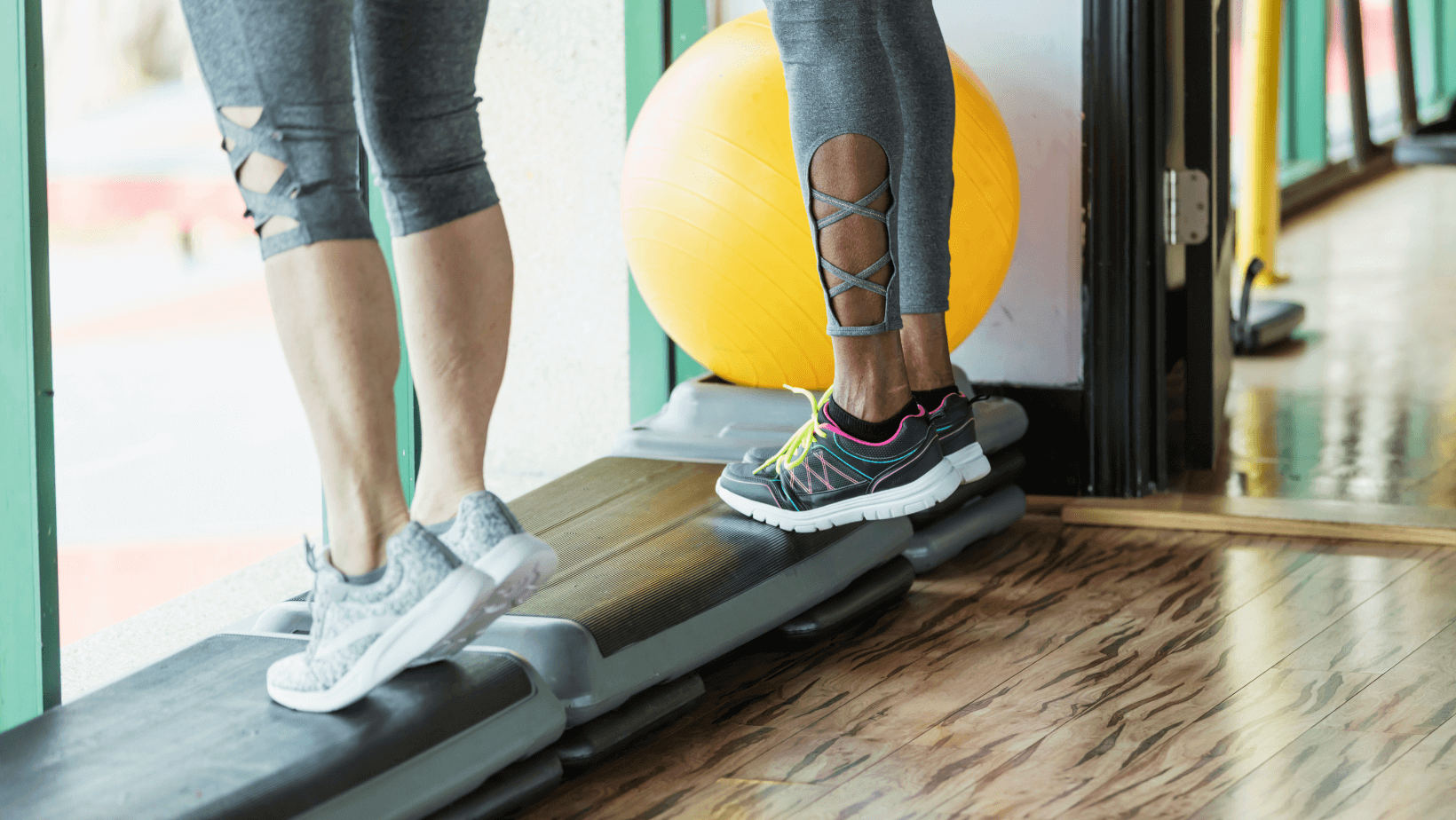
Cooldowns and Post-Workout Stretching
Prevent sore muscles and reduce odds of injury the next workout session with cooldown routines. Great cooldown activities for older people include:
- Lightly jogging or walking for a few minutes.
- Standing calf stretches (place both hands on the wall, and push back with each leg, one at a time).
- Corpse pose (savasana) for roughly 5 minutes, a yoga pose where the person is flat on their back on the ground, with arms at the side. The point is to consciously relax the entire body.
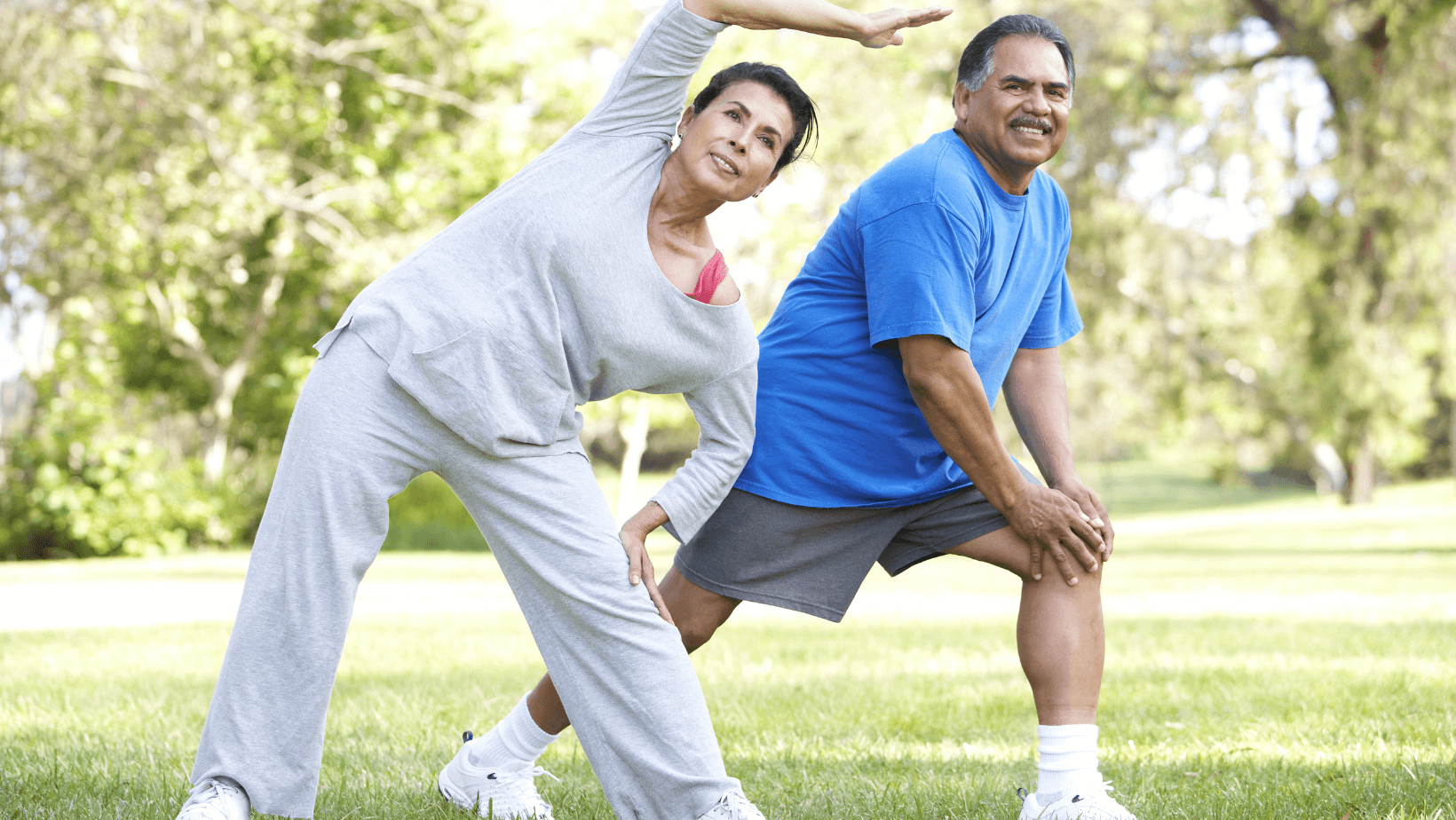
Senior Health and Fitness at St. Andrew's
All senior living communities within the St. Andrew's network understand that wellness is composed equally of physical, mental, and spiritual activities that keep every part of the individual stimulated. That means that each community has regularly scheduled workout programs for residents to enjoy. Best of all, these activities are social as well as physical, helping every individual feel part of a larger, welcoming community.
Disclaimers: This article does not constitute professional medical advice. The information in this article cannot be used to diagnose, treat, prevent, or cure any disease or condition. Always direct exercise questions or health concerns to a licensed trainer, physical therapist, or other medical professional. This article has not been medically reviewed.

